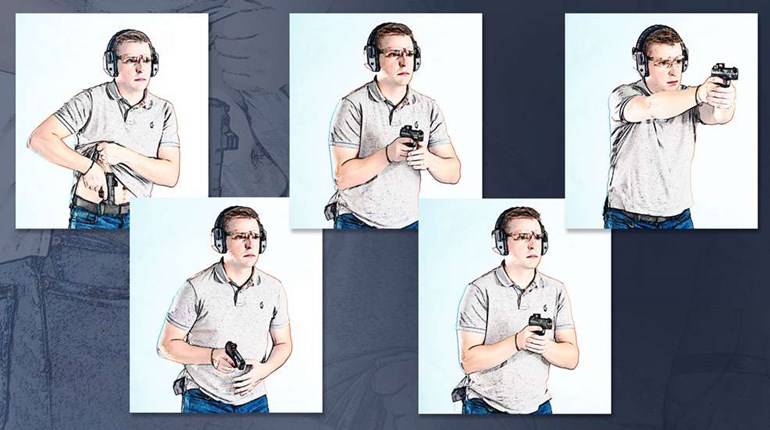
Dry practice—that is, practicing with an unloaded firearm—has been around a long time. It was used to develop a steady shot even as early as the use of matchlock firearms, as the delay of these guns’ firing mechanisms required a steady hold and follow through with every shot. But even with modern firearm technology, dry practice is as important as—or more important than—live fire on the range.
With more than four decades of firearms training under my belt, including in the U.S. Army, plus competition experience and practical application on the street as a police officer, I’ve learned the importance of good dry-practice training because it builds muscle memory to help us avoid anticipating recoil or flinching from the muzzle blast.
For it to be truly effective, however, you need to practice more than just the easy, controlled shots. So how do you take your dry practice up to a defensive level? Using a laser training device is the best method I’ve found. Various systems exist, from video-based to apps to static targets. (I started working with the LASR and LASR X systems for training years ago and eventually started working with the company directly.)
Time Yourself
To start, I recommend determining your “response” time.
1. Aim at the intended target with the laser-training handgun.
2. With your finger on the trigger, take up the slack until the final engagement point is reached.
3. Utilizing the timing device and a random start, engage the target at the first audible sound of the start tone. (If the system offers a visual start, use that as well to add more sensory engagement.)
4. Repeat three to five times to establish your average. Most people will typically have a response time of 0.05-0.08 seconds. Practice can decrease response time dramatically, perhaps down to 0.02-0.03 seconds.
5. Now holster or secure your handgun with the intended carry method. With a natural, unassuming stance (for defensive training) or at the ready (for competition purposes), repeat the above drill, engaging the target with the holstered handgun and recording the time of your first shot on the intended target. Subtracting your average response time from your overall time will give you a very accurate indication of your first shot.
The last step of this drill can be repeated utilizing any method of carry, holster type and position to determine what works best for you. This is absolutely the safest method that I have found to determine the best position and concealment method for fast deployment.
Multiple Targets
Now, let’s move to multi-target drills. Here’s where a very bad habit can be developed when not properly using a laser-based system. Set up multiple targets, placing them apart from each other and at different ranges. (You can also fake the range difference in your perception with some targets being larger or smaller.) Here are some things to remember when using these systems:
Train for life. Treat the training gun as if it were a live firearm—do not become complacent with the fact that it is not capable of firing a projectile. Follow the applicable safety rules every time.
Focus on fundamentals. Watch the front sight and maintain trigger control.
Don’t chase the laser splash! Often, the shooter will mistake their ability to hit a target by walking the laser onto the intended target simply by watching the previous strike and following the laser to the target. This problem can be prevented by engaging multiple targets. For multiple shots on one target and more-
realistic training, an invisible (infrared) laser can be used if the training system supports it. I have found that there are some training guns that have the laser on constantly while the trigger is engaged, but, while this works great for training sight alignment, it can develop into poor practice when used as a training device. Ideally, use a dry-practice training device that allows you to use your own firearm or one that simulates your own firearm with a pulsing laser to practice proper trigger engagement.
Be creative. Whether a static-target system or video-based system is being used, create scenarios where targets are engaged from sitting positions, simulate room-clearing exercises or even try out vehicle scenarios (inside; let’s not alarm the neighbors). How often can family members train real-life scenarios? Laser systems are perfect for this.
As previously mentioned, the most-important shot fired from a firearm in a defensive act is the first shot. By developing a training system and utilizing dry-practice exercises correctly, you can save ammo and build the right skills and the best habits.

































